Do you have a sizable backyard? You might be able to turn it into some serious cash flow, especially since starting a business at home reduces youro ...
Given the intense market competition, it might be wise to specialize in a few service areas.
We earn commissions if you shop through the links below. Read more
Written by: Carolyn Young
Carolyn Young is a business writer who focuses on entrepreneurial concepts and the business formation. She has over 25 years of experience in business roles, and has authored several entrepreneurship textbooks.
Edited by: David Lepeska
David has been writing and learning about business, finance and globalization for a quarter-century, starting with a small New York consulting firm in the 1990s.
Published on November 10, 2021

Investment range
$7,410 - $20,930
Revenue potential
$500,000 - $1 million p.a.
Time to build
3 - 6 months
Profit potential
$50,000 - $100,000 p.a.
Industry trend
Growing
Commitment
Full-time
Here are some facts to consider when starting your landscaping business:
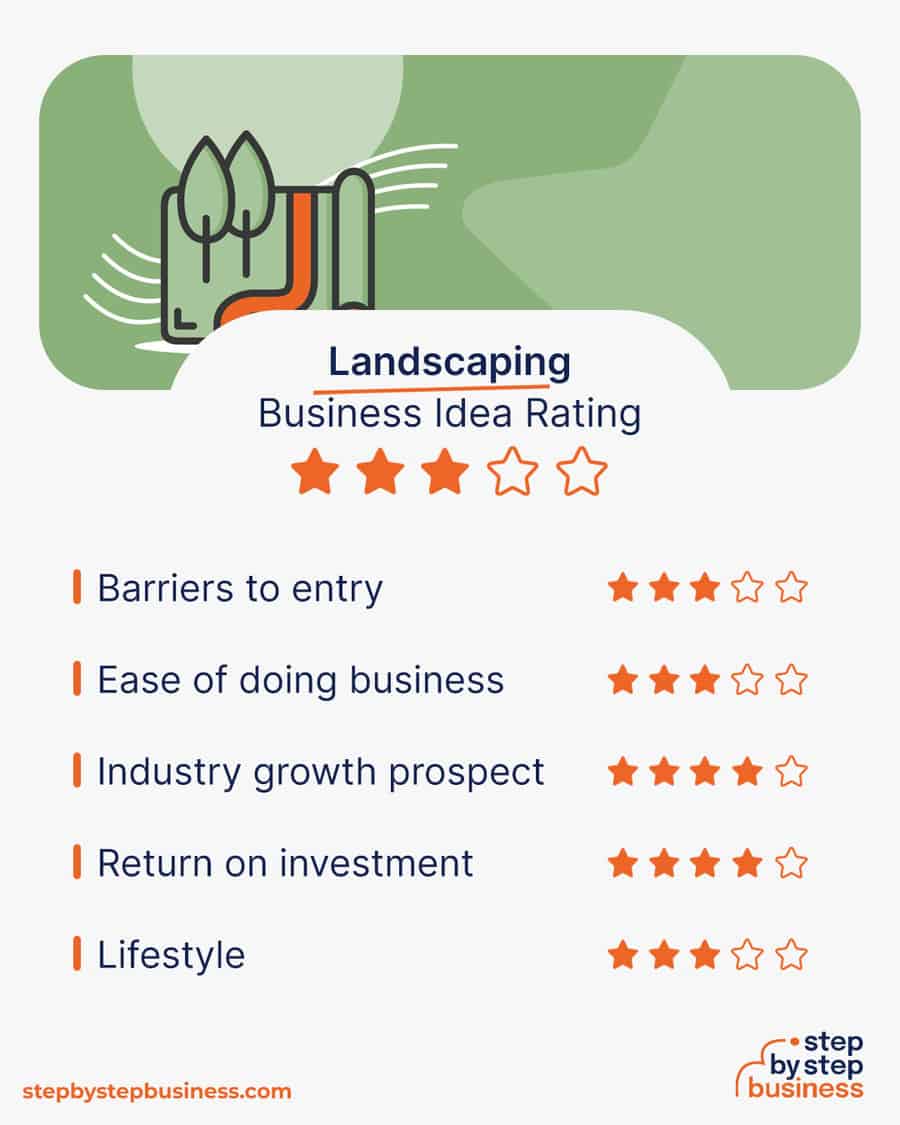
Ask yourself, what are the downsides and upsides of launching a landscaping company? A viable business idea should offer more advantages than disadvantages.
Below are some pros and cons of landscaping:
In 2019, the National Association of Landscape Professionals (NALP) launched an apprenticeship program in collaboration with the US Department of Labor.((https://www.landscapeprofessionals.org/apprenticeship)) The goal is to train more workers to fill labor shortages in the landscaping market. Landscaping mostly requires skilled labor, and this program helps ensure adequate skills development. As their work is key to its success, a new landscaping enterprise must compensate workers appropriately, or struggle with high turnover.
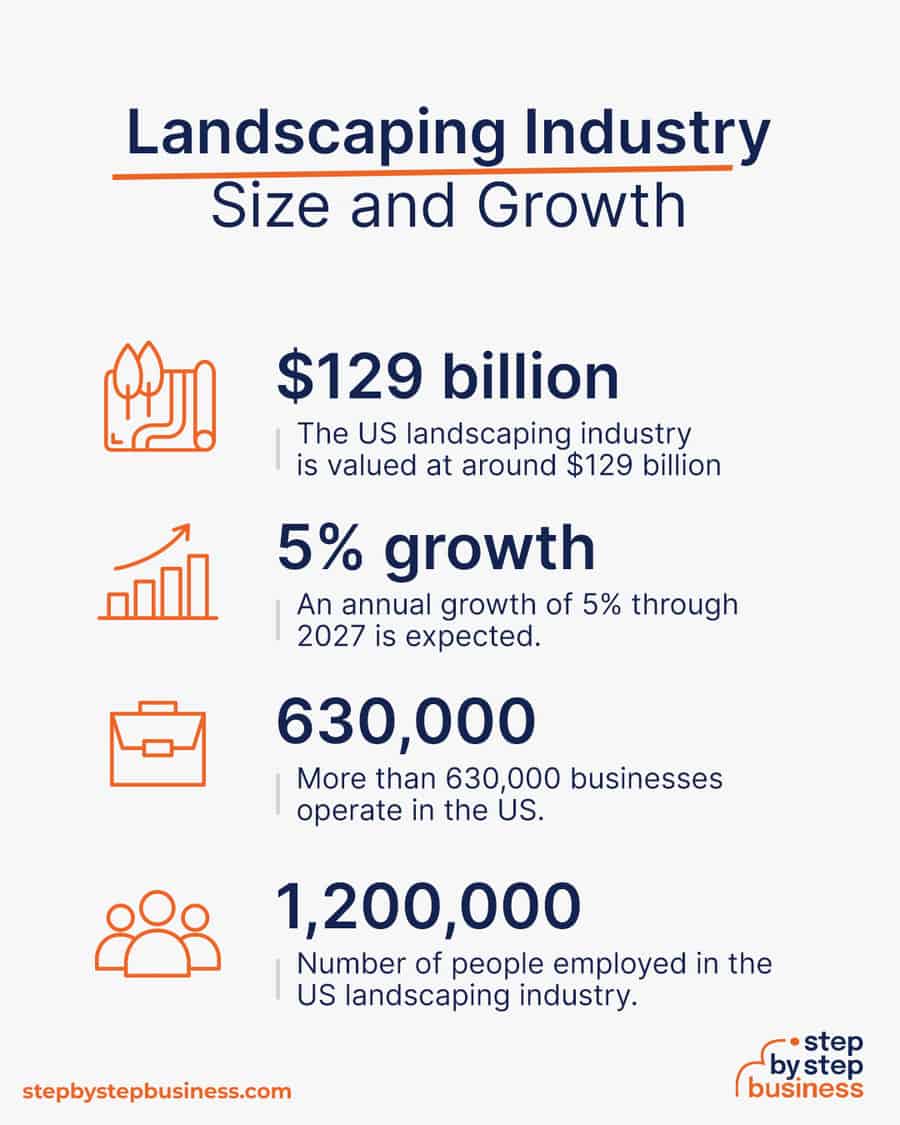
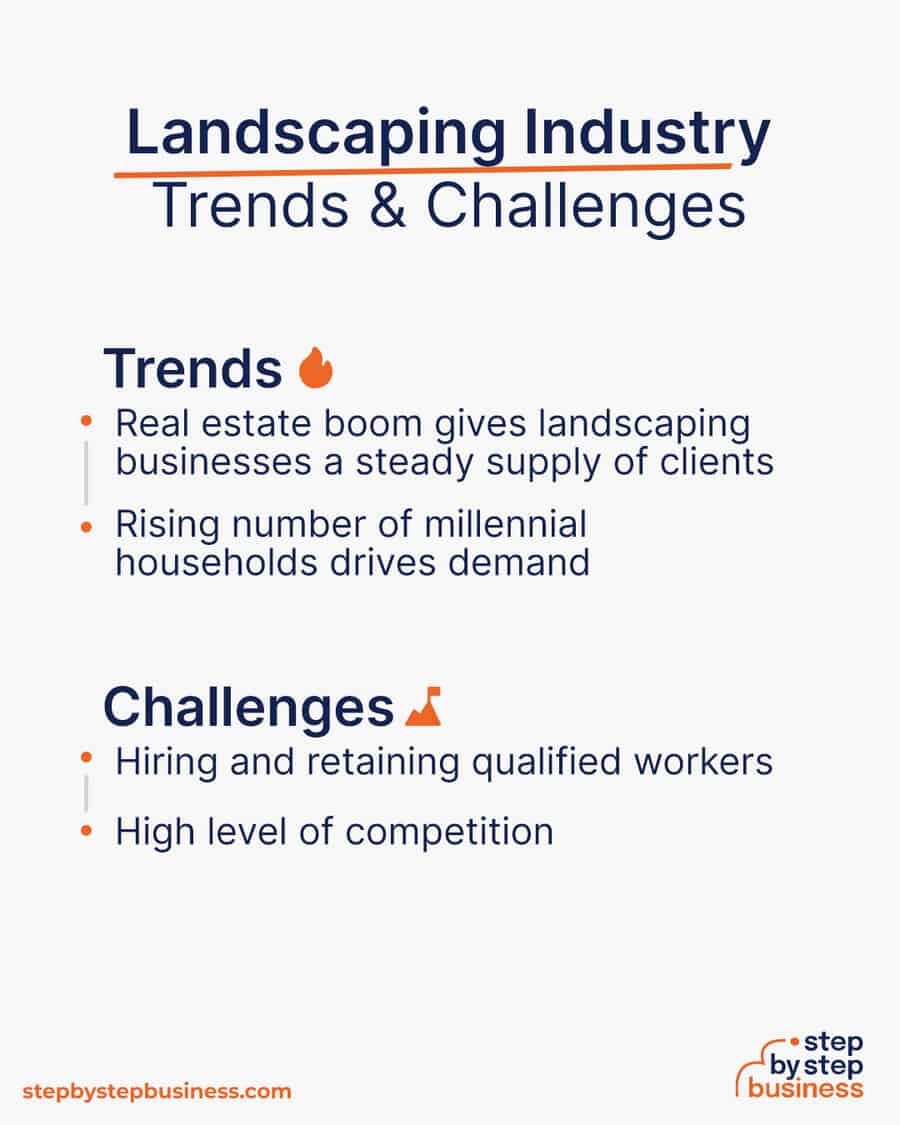
Landscaping trends are:
Challenges in the landscaping industry include:
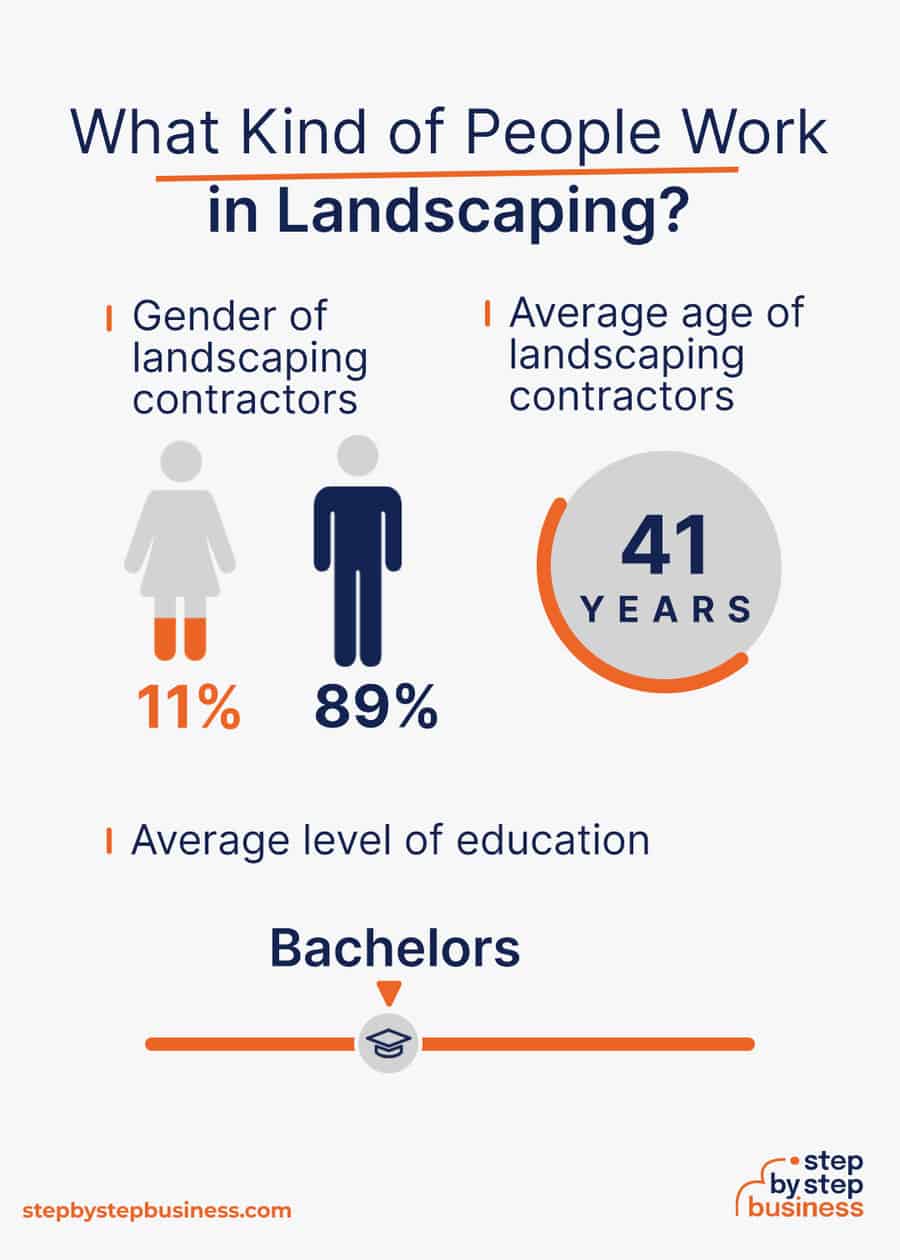
Startup costs for a landscaping firm range from about $7,500 and $20,000, according to Step by Step Research, with an average of about $15,000 in investment. The primary costs are a truck and trailer, plus equipment including mowers, trimmers, and wheelbarrows.
You’ll need several items to successfully launch a landscaping business, including specialty equipment. Here’s a list to get you started:
| Startup Costs | Ballpark Range | Average |
|---|---|---|
| Mower | $300 - $4,000 | $2,150 |
| Trimmer/Edger | $150 - $300 | $225 |
| Landscaping equipment | $400 - $600 | $500 |
| Truck | $5,000 - $10,000 | $7,500 |
| Trailer | $1,000 - $5,000 | $3,000 |
| Licenses and permits | $110 - $130 | $120 |
| Insurance | $200 - $400 | $300 |
| Marketing cost | $250 - $500 | $375 |
| Total | $7,410 - $20,930 | $14,170 |
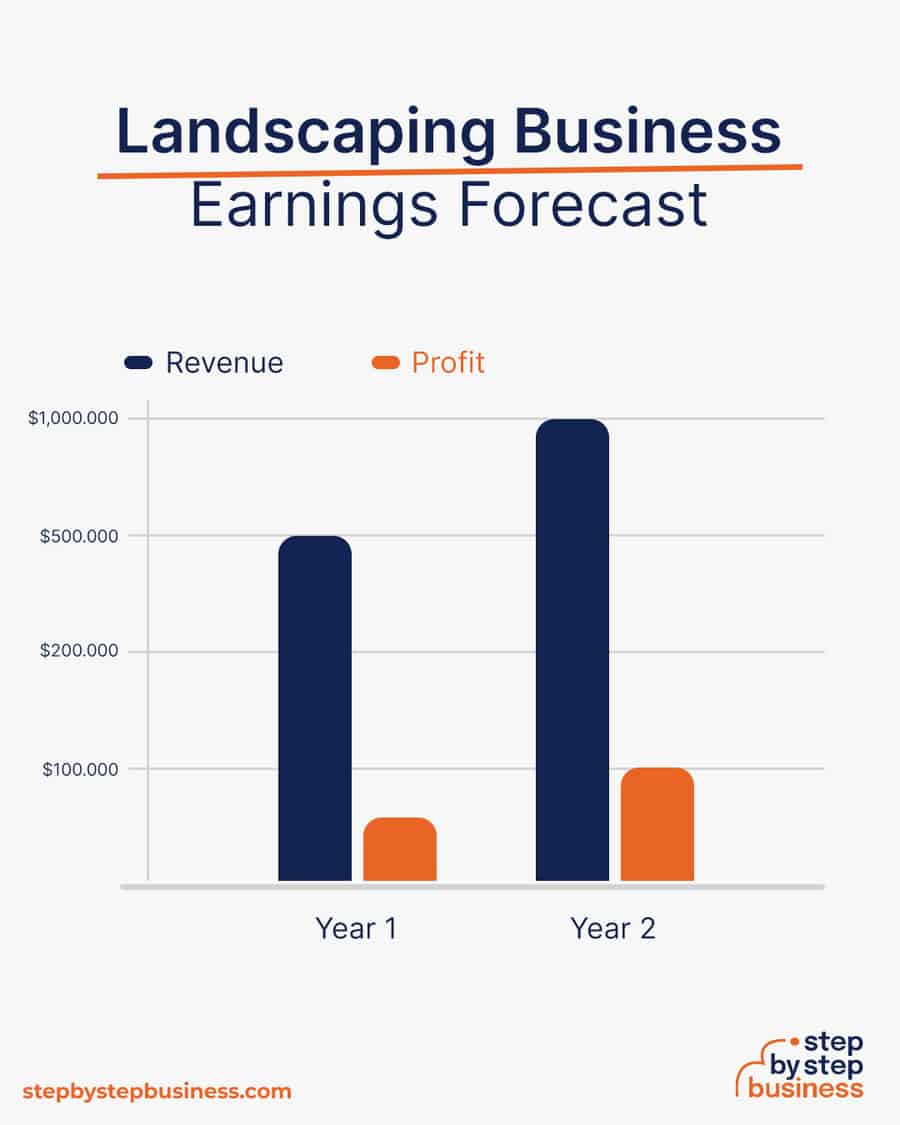
Your earnings as a landscaping business will depend on the type of work you do and its seasonality. Landscaper salaries vary depending on location but tend to range from $23,000 to $54,000, according to advisory site Career Explorer.((https://www.careerexplorer.com/careers/landscaper/salary/))
Industry profit margins usually range from 8% to 12%, which means revenue of $500,000 to $1 million would lead to $50,000-$100,000 in profit.
If you can charge $5,000 per landscaping job and your firm does 100 jobs per year, then you should see an annual revenue of $500,000 and a profit of $50,000, assuming a 10% margin. As you build your business, you could do 200 jobs a year at the same rate, bringing in $1 million in revenue and a tidy profit of $100,000.
Barriers to entry for a landscaping business are moderately high. Significant challenges for new entrants include:
Now that you know what’s involved in starting a landscaping business, it’s a good idea to hone your concept in preparation to enter a competitive market.
Market research will give you the upper hand, even if you’re already positive that you have a perfect product or service. Conducting market research is important, because it can help you understand your customers better, who your competitors are, and your business landscape.
An aspiring landscaper should know what separates landscaping from simple lawn care. The latter is mainly about lawn mowing, but also includes weeding, pruning, fertilization and other maintenance services. The former, on the other hand, goes much further.
Landscaping refers mainly to the designing and building out of lawns, gardens, and other outdoor areas, and can include the addition of rock paths, vegetable gardens, sculptures, fountains, and other fixtures, as well as fencing and ground contouring. You could say the landscaper builds the lawn care specialist’s place of work.
Having said that, most landscapers also provide lawn care services, given predictable client demand, and some even make that central to their business. As the business owner, you will decide which services your landscaping firm will offer clients.
Given the intense market competition, it might be wise to specialize in a few service areas.
Research the most in-demand services in your area, for residential and commercial landscapes, and structure your business model around the top options. You may also want to research the profit margins for landscape design and installation versus maintenance and lawn care. Whatever services you choose, it’s generally wise to experiment with pricing structures, starting low first to offer clients a discount and build a reputation.
The increase in US real estate values and residential construction in recent years means higher budgets for landscapers installing fixtures or performing lawn, tree, and garden care. Opportunities abound as new homeowners look to build out their lawns and perhaps add productive fruit and vegetable gardens.
An aspiring landscaper should understand that they will likely have more creative freedom when working with households rather than commercial properties.
The type of landscaping work you stress will dictate your equipment and expertise needs, each of which will require investments of time, energy, and money.
Some of the most common service niches in the landscaping industry include:
Service advisory Home Advisor says landscaping services cost between $4 and $40 per square foot, depending on the scope of work.((https://www.homeadvisor.com/cost/landscape/)) For example, basic services that include thatching, aerating, and flower planting would cost $4-$6 per square foot, while a full tear-out and remodeling job would cost $10-$40 per square foot.
Most US landscape contractors are paid $25-$35 per hour, or an average hourly wage of $30, depending on the intensity of the work, location, and required expertise.((https://www.salary.com/research/salary/posting/landscape-contractor-hourly-wages)) If you intend to do more installation than maintenance, this will make each job more time-consuming, locking up your laborers for longer periods of time. Of course, you’ll also be able to charge more for installation services.
Gaining a solid understanding of the various factors involved is key to building an effective pricing model for and balancing equipment and labor costs to achieve your desired profit margin.
Once you know your costs, you can use this Step By Step profit margin calculator to determine your mark-up and final price points. Remember, the prices you use at launch should be subject to change if warranted by the market.
Will your landscaping firm primarily service residential homes or commercial properties — or both? Where you focus your team’s efforts should be determined by a combination of the capabilities of your equipment and labor force, your desired margins, and your personal preferences.
Residential properties may allow for more custom work (such as working with the homeowner to develop an appealing landscape design), while commercial work often involves larger spaces and more labor, which means higher revenues from fewer jobs. Residential landscaping is likely to offer more opportunities, especially for a new landscaper.
Industry analysts generally see three advantages in switching from residential to commercial landscaping work: fewer accounts; higher level of professionalism; and consistent budgets.
Doing residential and commercial work may mean expanding your staff to meet demand.
In the early stages, you may want to operate your business from home to cut costs. But as your business grows and operations intensify, you will likely hire more workers and maybe move to an office and rent a storage facility. You can find commercial space to rent in your area on Craigslist, Crexi, and Commercial Cafe.
When choosing a commercial space, you may want to follow these rules of thumb:
Here are some ideas for brainstorming your business name:
Discover over 370 unique landscaping business name ideas here. If you want your business name to include specific keywords, you can also use our landscaping business name generator. Just type in a few keywords and hit “generate” and you’ll have dozens of suggestions at your fingertips.
Once you’ve got a list of potential names, visit the website of the US Patent and Trademark Office to make sure they are available for registration and check the availability of related domain names using our Domain Name Search tool below. Using “.com” or “.org” sharply increases credibility, so it’s best to focus on these.
Finally, make your choice among the names that pass this screening and go ahead with domain registration and social media account creation. Your business name is one of the key differentiators that sets your business apart. Once you pick your company name, and start with the branding, it is hard to change the business name. Therefore, it’s important to carefully consider your choice before you start a business entity.
Here are the key components of a business plan:

If you’ve never created a business plan, it can be an intimidating task. You might consider hiring a business plan specialist to create a top-notch business plan for you.
Registering your business is an absolutely crucial step — it’s the prerequisite to paying taxes, raising capital, opening a bank account, and other guideposts on the road to getting a business up and running.
Plus, registration is exciting because it makes the entire process official. Once it’s complete, you’ll have your own business!
Your business location is important because it can affect taxes, legal requirements, and revenue. Most people will register their business in the state where they live, but if you are planning to expand, you might consider looking elsewhere, as some states could offer real advantages when it comes to landscaping services.
If you’re willing to move, you could really maximize your business! Keep in mind, it’s relatively easy to transfer your business to another state.
Business entities come in several varieties, each with its pros and cons. The legal structure you choose for your landscaping firm will shape your taxes, personal liability, and business registration requirements, so choose wisely.
Here are the main options:

We recommend that new business owners choose LLC as it offers liability protection and pass-through taxation while being simpler to form than a corporation. You can form an LLC in as little as five minutes using an online LLC formation service. They will check that your business name is available before filing, submit your articles of organization, and answer any questions you might have.
Choose Your State
The final step before you’re able to pay taxes is getting an Employer Identification Number, or EIN. You can file for your EIN online or by mail or fax: visit the IRS website to learn more. Keep in mind, if you’ve chosen to be a sole proprietorship, you can simply use your social security number as your EIN.
Once you have your EIN, you’ll need to choose your tax year. Financially speaking, your business will operate in a calendar year (January–December) or a fiscal year, a 12-month period that can start in any month. This will determine your tax cycle, while your business structure will determine which taxes you’ll pay.
The IRS website also offers a tax-payers checklist, and taxes can be filed online.
It is important to consult an accountant or other professional to help you with your taxes to ensure you are completing them correctly.
Securing financing is your next step and there are plenty of ways to raise capital:
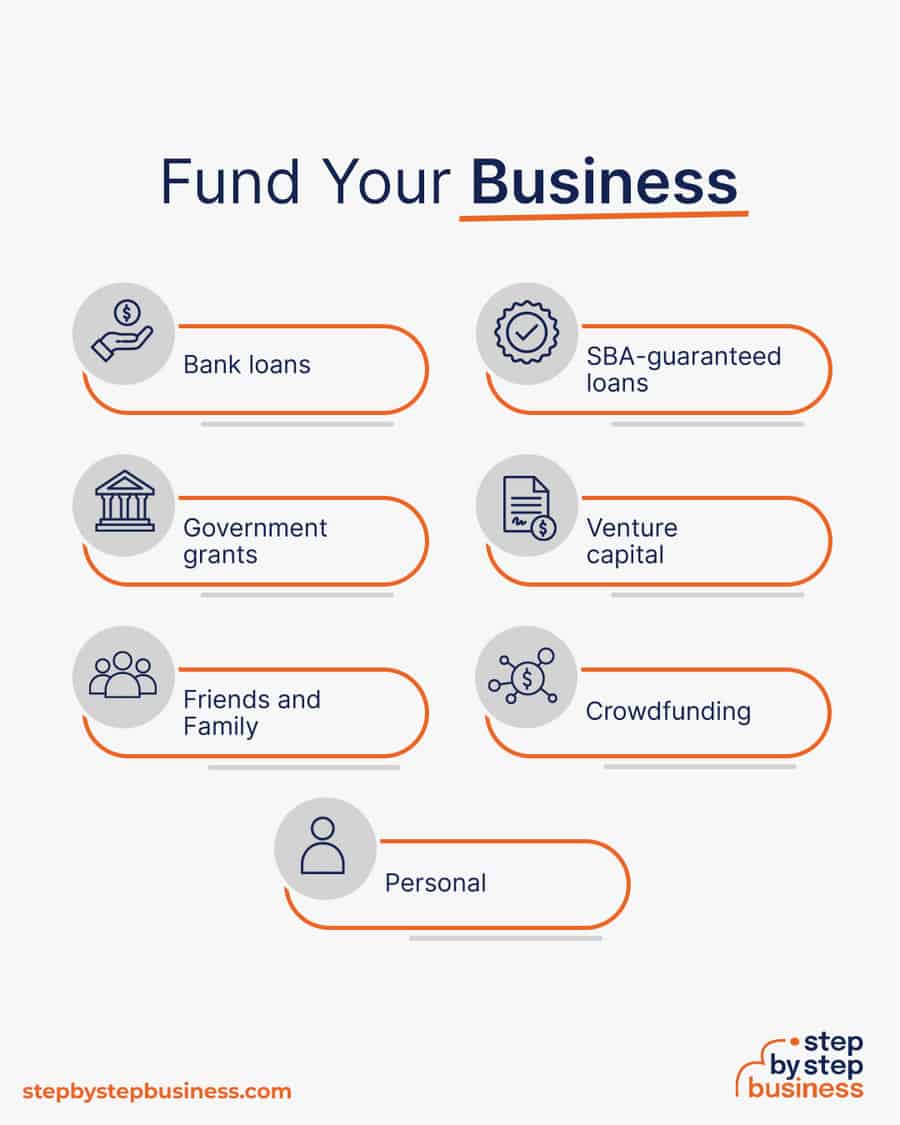
Bank and SBA loans are probably the best option, other than friends and family, for funding a landscaping business. You might also try crowdfunding if you have an innovative concept.
Starting a landscaping business requires obtaining a number of licenses and permits from local, state, and federal governments.
The National Association of Landscaping Professionals (NALP) offers a handy guide to upgrade your landscaping business through education, certifications, and membership. If you plan on spraying pesticides, you will likely require additional certifications. The US EPA website includes a guide on how to get certified as a pesticide applicator.
Federal regulations, licenses, and permits associated with starting your business include doing business as (DBA), health licenses and permits from the Occupational Safety and Health Administration (OSHA), trademarks, copyrights, patents, and other intellectual properties, as well as industry-specific licenses and permits.
You may also need state-level and local county or city-based licenses and permits. The license requirements and how to obtain them vary, so check the websites of your state, city, and county governments or contact the appropriate person to learn more.
You could also check this SBA guide for your state’s requirements, but we recommend using MyCorporation’s Business License Compliance Package. They will research the exact forms you need for your business and state and provide them to ensure you’re fully compliant.
This is not a step to be taken lightly, as failing to comply with legal requirements can result in hefty penalties.
If you feel overwhelmed by this step or don’t know how to begin, it might be a good idea to hire a professional to help you check all the legal boxes.
Before you start making money you’ll need a place to keep it, and that requires opening a bank account.
Keeping your business finances separate from your personal account makes it easy to file taxes and track your company’s income, so it’s worth doing even if you’re running your landscaping business as a sole proprietorship. Opening a business bank account is quite simple, and similar to opening a personal one. Most major banks offer accounts tailored for businesses — just inquire at your bank to learn about their specific rates and features.
Banks vary in terms of offerings, so it’s a good idea to consider your options to choose the best plan that works for you. Once you choose your bank, you’ll need to bring your EIN (or Social Security Number if you decide on a sole proprietorship), articles of incorporation, and any other legal documentation that proves your business is registered.
Business insurance is an area that often gets overlooked yet is vital to your success as an entrepreneur. Insurance protects you from unexpected events that can have a devastating impact on your business.
Here are some types of insurance to consider:

As opening day nears, prepare for launch by reviewing and improving some key elements of your business.
Being an entrepreneur often means wearing many hats, from marketing to sales to accounting, which can be overwhelming. Fortunately, many websites and digital tools are available to help simplify many business tasks. We examine several of them below.
Recommended software for landscaping would include Aspire for client relations, Jobber for accounting, BuilderTrend for project management, and SmartDraw for 3D design.
Website development is crucial because your site is your online presence and needs to convince prospective clients of your expertise and professionalism.
You can create your own website using website builders. This route is very affordable, but figuring out how to build a website can be time-consuming. If you lack tech-savvy, you can hire a web designer or developer to create a custom website for your business.
They are unlikely to find your website, however, unless you follow Search Engine Optimization (SEO) practices. These are steps that help pages rank higher in the results of top search engines like Google.
Here are some powerful marketing strategies for your future business:

Unique selling propositions, or USPs, are the unique characteristics of a product or service that sets it apart from the competition. Customers today are inundated with buying options, so you’ll have a real advantage if they are able to quickly grasp how your landscaping firm meets their needs or wishes. It’s wise to do all you can to ensure your USPs stand out on your website and in your marketing and promotional materials, stimulating buyer desire.
Global pizza chain Domino’s is renowned for its USP: “Hot pizza in 30 minutes or less, guaranteed.” Signature USPs for your landscaping business could be:
You may not like to network or use personal connections for business gain. But your personal and professional networks likely offer considerable untapped business potential. Maybe that Facebook friend you met in college is now running a landscaping business, or a LinkedIn contact of yours is connected to dozens of potential clients. Maybe your cousin or neighbor has been working in landscaping for years and can offer invaluable insight and industry connections.
The possibilities are endless, so it’s a good idea to review your personal and professional networks and reach out to those with possible links to or interest in landscaping. You’ll probably generate new customers or find companies with which you could establish a partnership. Online businesses might also consider affiliate marketing as a way to build relationships with potential partners and boost business.
You may not need to hire any employees if you are starting out small from your home. But as your business grows, you will need to hire employees for various job roles. The potential employees for a landscaping business might include:
At some point, you may need to hire all of these positions or simply a few, depending on the size and needs of your business. You might also hire multiple workers for a single role or a single worker for multiple roles, again depending on need.
Free-of-charge methods to recruit employees include posting ads on popular platforms such as LinkedIn or Facebook. You can also use free classified sites like Jobs and AngelList. You might also consider a premium recruitment option, such as advertising on Indeed, Glassdoor, or ZipRecruiter. Further, if you have the resources, you could consider hiring a recruitment agency to help you find talent.
Besides the real estate boom, a growing interest in gardening that accelerated during the pandemic lockdowns has fueled the demand for landscaping services. Market prospects look bright with the pandemic winding down and the economy recovering. US consumers now have bigger disposable income that may be spent on landscaping services.
You might want to consider investing in potential growth areas such as lawn, tree, and garden installation, maintenance and care for residential homes and complexes, and commercial properties. With all your knowledge, you’re now ready to start your entrepreneurial journey. It’s time to roll up your sleeves and launch your landscaping business.
Sure! There’s no formal education requirement, and most states do not require a license to service residential or commercial properties. However, doing a good enough job to satisfy clients will require some degree of knowledge, skills, and expertise.
According to market advisor Irrigation and Green Industry, most landscaping businesses fail due to poor pricing of their services. You have to balance pricing your work for competitiveness while also hitting your profit target and not underpaying your workers. New landscapers should remain flexible in their pricing until they’ve achieved enough work to get it right.
The landscaping software website Arborgold provides a handy guide on bidding for jobs, advising landscapers to know your client’s needs, estimate labor and equipment costs, outline a project budget, and follow up.
Formal education is not typically required to start a landscaping business. However, having a background or education in landscape design, horticulture, or a related field can provide you with valuable knowledge and skills. Consider pursuing courses, certifications, or a degree program to gain a deeper understanding of landscaping principles, plant care, design concepts, and business management.
The most profitable services in a landscaping business can vary depending on factors such as the local market, customer demand, and competition. Some services that tend to be profitable include landscape design and installation, hardscaping (such as patios and retaining walls), irrigation system installation and maintenance, tree care and removal, and ongoing landscape maintenance contracts.
Generally, areas with a growing population, high demand for landscaping services, and favorable weather conditions can be good places to start a landscaping business.
Consider offering additional services that complement your existing offerings, such as outdoor lighting installation, lawn care, or plant sales. This can help attract new customers and increase revenue streams.

Published on December 1, 2022
Do you have a sizable backyard? You might be able to turn it into some serious cash flow, especially since starting a business at home reduces youro ...
Read Now

Published on December 1, 2022
The services sector is undoubtedly the biggest economic sector in the US as it accounts for nearly 70% of the country’s gross domestic product. It ...
Read Now

Published on July 13, 2022
Many major American businesses depend on outdoor activities, such as The North Face or Columbia. But there are also countless smaller businessesthat ...
Read Now
No thanks, I don't want to stay up to date on industry trends and news.
Comments